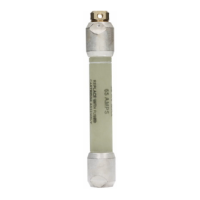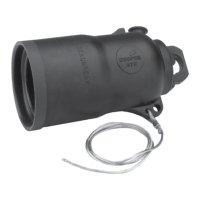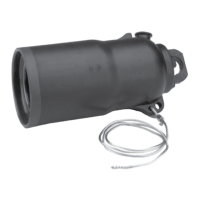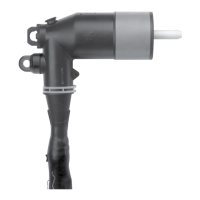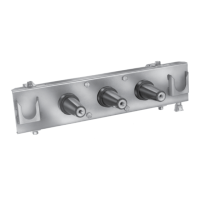Control setup
Ratio correction
It may be necessary to "ratio correct" the control voltages
from the regulator. Ratio correction is a fine adjustment
of the load side voltage signal to an approximate 120 volt
base. The adjustment is made using the ratio correction
transformer (RCT). The magnitude of the voltage signal
coming to the control box is dependent upon the system
voltage applied to the regulator and the regulators internal
potential transformer ratio. The application of the RCT allows
for the fine adjustment of the incoming voltage as near as
possible to 120 volts. The CRA is designed to work with the
120 volt signal from the load side of any regulator. The CL-7
control does not require a fine adjustment to the source-side
or differential voltage signal, but instead uses the internal PT
ratio and software correction to determine the source side
voltage.
ote:N The CRA is shipped from the factory set for no
ratio correction. Examine the regulator nameplate
to determine if ratio correction is required for your
application.
If the regulator nameplate indicates that the load control
signals at nominal system voltage are something other than
120 volts, such as 115, 125, etc., it will be necessary to
utilize the RCT located on the back panel of the CRA. See
Figure 2. Ratio correction is achieved by applying the load
voltage signals to the RCT autotransformer to adjust the
output as near as possible to 120 volts. How much ratio
correction required can be determined by using the internal
PT ratio and system voltage and then determining the
required ratio of the RCT.
Ratio correction and control programming
Source voltage control signal (when present)
If the regulator is supplied with a source-side signal
(Siemens green "U2"; GE #16AWG black 32; Eaton/McGraw-
Edison white/black) the appropriate lead will be terminated
on the top of the V6 knife switch. Ratio correction is
not required, but the correct internal PT ratio must be
entered into the control. The control must also be set up to
recognize the signal sent from the PT.
1. Determine the internal PT ratio by dividing the nominal
system voltage by the control source voltage and
entering this value at FC 44 (enter function code 44
and then press the down arrow). On Eaton/McGraw-
Edison regulators, the internal PT ratio can be read
from the voltage chart.
Example: If the regulator nameplate lists a control
source voltage of 120 volts for a system voltage of 7620,
the Internal PT Ratio will be 7620/120 = 63.5.
2. The Vin PT Setting must be correctly set at FC 146.
Select the correct setting as follows:
• Select Vdiff without RCT2 when an internal differential
PT (IDPT) supplies the source-side voltage by
measuring the voltage difference between the source
and the load. This is standard for Eaton/McGraw-Edison
voltage regulators.
• Select Vin if the a source-side PT provides a voltage
signal measured between the source and source/load.
This is standard on voltage regulator manufactured by
Siemens and GE.
Load control signal (always present)
The regulator will be supplied with a load-side signal
(Siemens blue "P2"; GE 20 orange/black or 21 orange or 22
blue; Eaton/McGraw-Edison black). The appropriate lead will
be terminated on the top of the V1 knife switch. The RCT
must be set up correctly and the Overall PT Ratio must be
set in the control.
ote:N Some Siemens type A regulators may not be
equipped with a load control signal. Eaton's control
will not work on such devices.
1. If the regulator nameplate identifies the load control
signal as 120 volts for the system voltage used, no ratio
correction is necessary. Determine the Overall PT ratio
by dividing the nominal system voltage by the control
voltage and enter this value at FC 44. This value is listed
on Eaton/McGraw-Edison nameplates in the voltage
chart for the appropriate system voltage.
Example: If the regulator nameplate lists a control
voltage of 120 volts for a system voltage of
7620, the Overall PT Ratio will be 7620/120 =
63.5.
CAUTION
Over-voltage hazard. Equipment damage. Insure that the
nominal PT voltage plus 10% does not exceed 140 Vac.
In such a case, do not connect the source PT, but instead
use the source-voltage calculation. A source-PT voltage
above 150 Vac will result in equipment damage. VR-T244.0
19CL-7 control replacement assembly installation instructions and service information MN225017EN October 2016

